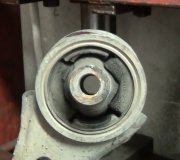At some point the engine cross member was removed to service the engine, transmission, or steering system. Its location wasn't marked, and the cross member wasn't reinstalled in the same orientation. It was shifted to one side a little. That moves the bottoms of both wheels to one side and causes them to both tip to the left or to the right. Tires want to pull in the direction they're leaning. That's called "camber" and is one of the three main alignment angles that must be set on all cars, (except most front-wheel-drive Fords that were poorly-designed without adjustments). Camber can be adjusted on your car to bring the wheels back to standing straight up, but that doesn't address "steering axis inclination", (SAI), a secondary alignment angle that we only look at when looking for the cause of an elusive problem. In this case you did a better job of describing the typical symptom than I do when I teach my Alignment class.
In my sad drawing from one of my Notes pages, it shows the results of shifting the cross member to one side, then adjusting camber during a quickie alignment. The mechanic has to look closely at SAI. It is measured automatically by all alignment computers but we don't normally pay much attention to it. There is never a spec given. All that is important is it must be the same on both sides, within 0.2 degrees. A typical reading is around 28 to 32 degrees so you can see that tolerance is pretty tight.
This can only happen on GM front-wheel-drive cars. Chryslers use special bolts that set the orientation of their removable cross members. Fords are usually welded and not removable. You need to have the car aligned, but you have to specify the complaint of miserable handling. Once the preliminary measurements are taken, the mechanic will use a pry bar to slide the cross member sideways until SAI is exactly equal on both sides, THEN he will have to readjust camber. Most shops provide a printout that shows the readings from before they made any changes, and the readings when they were done. I'd be interested to see what the original SAI readings were.
Image (Click to make bigger)
SPONSORED LINKS
Wednesday, February 20th, 2013 AT 1:45 AM




